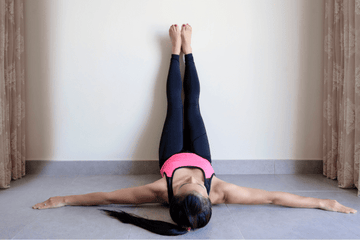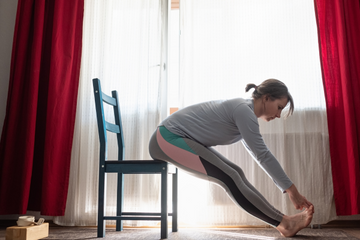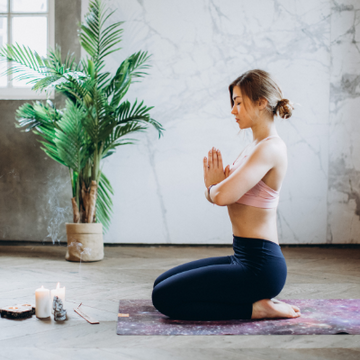
The Ultimate Wall Yoga Guide – 25 Day Challenge with 5 Step-by-Step Poses
Elevate your yoga practice with Wall Yoga!
Delve into the blog for innovative techniques and revitalizing poses designed for all levels, from beginner to advanced. Discover how leveraging the support of a wall enhances balance, flexibility, and strength while deepening relaxation.
Get the step-by-step guide here!
Did you know that incorporating the humble wall into your practice can enhance the benefits of yoga?
Amid the mosaic of yoga styles and hybrids, wall yoga has emerged as a restorative yet transformational practice. With support from the wall, practitioners of all levels can deepen their stretches, refine their alignment, and enjoy a sense of security that aids relaxation.
We will explore some simple wall yoga poses and how to do them, the benefits of each.
What is Wall Yoga and Why is it a Game-Changer?
Wall yoga, much like the name suggests, involves the use of a wall to support the body in various yoga postures. The wall acts as both a stabilizer and an intensifier — it helps maintain correct alignment and allows for a deeper stretch through the use of leverage.
The addition of a wall to yoga offers a range of advantages:
- Precise Alignment: The wall acts as a point of reference, ensuring that you maintain an accurate alignment in complex poses.
- Improved Flexibility: By using the wall as support, you can gradually build flexibility by holding gentle stretches for longer periods.
- Increased Strength: With the wall assisting in bearing the body’s weight, you can safely build strength in your yoga practice.
- Enhanced Relaxation: The sense of security from the wall can be deeply comforting, promoting a more relaxed state in restorative poses.
- Accessible to All: Wall yoga is especially beneficial for beginners and those recovering from injuries, as it offers a safe and accessible way to practice.
Before we explore the five pivotal wall yoga poses, it's essential to consider how incorporating these into your regular routine can enhance your physical and mental well-being.
The Legs-Up Pose Against the Wall
The 'Legs-Up-the-Wall' pose, or Viparita Karani, is a rejuvenating inversion that drains stagnant fluid from the legs, easing aches and providing relief from mild back discomfort. It’s also a wonderful option for boosting circulation and calming the nervous system.
How to do it:
- Position your yoga mat perpendicular to the wall.
- Sit on one side of your mat and gently swivel your legs up the wall as you lie down on your back.
- Extend your arms out to your sides with your palms facing up for a surrendering sensation, or place your hands on your belly for an added grounding effect.
- Close your eyes, focus on your breath, and stay in this restful state for 5-15 minutes.
Benefits:
- Reduces Swelling: Elevating the legs helps to reduce inflammation and swelling, a common concern for those who spend long periods sitting or on their feet.
- Stress Relief: The gentle inversion stimulates the parasympathetic nervous system, encouraging the body to relax.
- Menstrual Comfort: Viparita Karani can help alleviate symptoms of PMS and menopause, offering a natural and soothing remedy.
- Mild Scoliosis Relief: Those with mild scoliosis may find the pose relieving as it can help to decompress the spine.
Arms Open Against the Wall Warrior 2
The 'Arms Open Against the Wall Warrior 2' is a hybrid that blends the traditional Warrior II pose with the support of a wall, for increased endurance, better postural awareness, and a deeper side stretch.
How to do it:
- Stand with your side body against the wall and spread your legs wide.
- Step one foot forward, bending the knee, aligning it over the ankle.
- Extend your arms out to the sides, keeping your back hand against the wall.
- Gaze forward over your front hand and hold for 5-8 breaths before repeating on the other side.
Benefits:
- Strengthens the Legs: This pose targets the quadriceps and the muscles around the hip, strengthening them over time.
- Lateral Flexion: The stance combined with the support of the wall allows for a deeper side stretch, enhancing flexibility in the obliques and intercostal muscles.
- Concentration Development: Maintaining the warrior II position requires focus on muscular engagement, coordination, and breath, thus enhancing mindfulness.
Wall Squat for Power and Balance
The 'Wall Squat,' also known as Utkatasana, brings quintessential leg day to yoga, working the quadriceps, hamstrings, and gluteal muscles. The wall provides stability and solidity, ensuring that the integrity of the squat is maintained.
How to do it:
- Start by standing with your back against the wall.
- Walk your feet forward and descend into a squat position, as if you were about to sit in a chair.
- Keep your back and hips in contact with the wall, with your knees over your ankles and feet flat on the ground.
- Hold for 30 seconds to a minute, then push through your heels to return to standing.
Benefits:
- Lower Body Strength: Utkatasana intensifies the leg workout, leading to improved strength and endurance in your lower body muscles.
- Enhanced Stable Core: The wall serves as a stabilizer, allowing for a focus on maintaining a strong and engaged core.
- Burning Calories: With activation of so many major muscles, the wall squat is an effective calorie burner that contributes to a toned lower body.
Supported Bridge Using the Wall for Spinal Health
The 'Supported Bridge Pose' with a wall assists in relieving pressure in the lower back, hips, and sacrum, while also acting as a gentle heart opener.
How to do it:
- Lie on your back with your feet flat on the wall, knees aligned with hips.
- Lift your hips, and slide a block or rolled-up towel under your sacrum for support.
- Extend your arms out to your sides with your palms facing up and close your eyes.
- Breathe deeply into your chest, staying for 2-5 minutes.
Benefits:
- Relief from Sciatic Pain: The Supported Bridge can alleviate sciatica by gently stretching the piriformis and other muscles that may be compressing the sciatic nerve.
- Soothes Stress and Anxiety: By opening the heart and chest, the pose releases tension and can help alleviate symptoms of stress and anxiety.
- Spinal Decompression: The passive nature of this backbend helps to decompress the spine, relieving any minor discomfort.
Push Arms Against the Wall for Upper Body Strength
For the upper body, 'Push Arms Against the Wall' is a strengthening posture that targets the chest, shoulders, and triceps. This pose is especially valuable for those seeking to develop strength for more advanced yoga arm balances.
How to do it:
- Stand facing the wall with your arms outstretched and palms flat against the wall at shoulder height.
- Lean forward slightly, maintaining a straight line from your heels to your head.
- Press against the wall as though you are attempting to move it.
- Breathe deeply and hold for 5-8 breaths.
Benefits:
- Upper Body Strength: The pose effectively works the muscles involved in pushing motions, thus increasing strength in the chest, shoulders, and arms.
- Stabilization: By pressing against the wall, you also activate the muscles of the core and back, improving overall upper body stability.
- On-Ramp to Arm Balances: The strength gained from practicing this pose translates into a stronger foundation for poses that involve supporting the body with the arms.
The 25-Day Wall Yoga Challenge
If these poses piqued your interest, you'll love the idea of a 25-day wall yoga challenge. This challenge is designed to gradually introduce the wall yoga practice, allowing you to explore each pose while fostering discipline and routine in your workout.
Get the challenge now
Included in the companion guide is a step-by-step breakdown of each wall yoga pose, the duration for which it should be held, and tips for enhancing your practice. With each day, you will discover new depths to your yoga practice and along with it, an improved sense of well-being.
Conclusion
The synergy between the simplicity of the wall and the depth of yoga practice opens up a world of benefits that are both physical and mental. Whether you're a seasoned yogi searching for a new edge to your practice or a fitness enthusiast investing in your well-being, wall yoga has something for everyone.
By integrating these poses into your daily routine, you're not just adding variety- you're building a foundation for strength, flexibility, and serenity that will radiate in every aspect of your life. I hope you enjoy giving this a try, and have fun!
Find out more and get the guide now!
FAQ's: How to practice Wall Yoga and the benefits:
How effective is Wall yoga?
What happens if you do 1 minute of wall yoga everyday?
Is Wall Yoga good for you?
Wall Yoga can be a beneficial exercise to help undo the effects of a more flexed posture. This helps decrease stress at the shoulders, allowing you to raise your arms overhead easier, and it helps keep your head more in line with your body, decreasing stress in your neck muscles.


